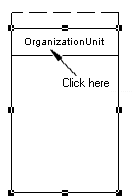To view or edit an organization unit's properties, double-click its diagram symbol or Browser or list entry. The property sheet tabs and fields listed here are those available by default, before any customization of the interface by you or an administrator.
|
Property |
Description |
|---|---|
Name/Code/Comment |
Identify the object. The name should clearly convey the object's purpose to non-technical users, while the code, which is used for generating code or scripts, may be abbreviated, and should not normally include spaces. You can optionally add a comment to provide more detailed information about the object. By default the code is generated from the name by applying the naming conventions specified in the model options. To decouple name-code synchronization, click to release the = button to the right of the Code field. |
|
Stereotype |
Extends the semantics of the object. You can enter a stereotype directly in this field, or add stereotypes to the list by specifying them in an extension file. |
|
Parent organization |
Specifies another organization unit as the parent to this one. For example, you may want to describe an organizational hierarchy between a department Dpt1 and a department manager DptMgr1 with DptMgr1 as the parent organization of Dpt1. The relationship between parent and child organization units can be used to group swimlanes having the same parent. For more information, see Grouping and Ungrouping Swimlanes. |
Keywords |
Provide a way of loosely grouping objects through tagging. To enter multiple keywords, separate them with commas. |
